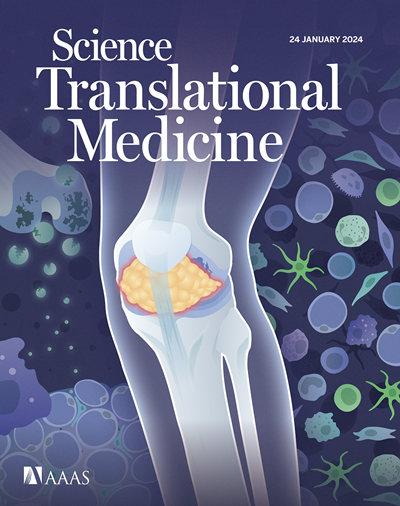在患者衍生小鼠模型中,精胺代谢通过 KAT7 的表达调节白血病干细胞和祖细胞的功能
IF 15.8
1区 医学
Q1 CELL BIOLOGY
引用次数: 0
摘要
急性髓性白血病(AML)是一种由称为白血病干细胞(LSCs)的罕见细胞亚群引发并维持的毁灭性疾病。白血病干细胞是导致疾病复发的罪魁祸首,因此迫切需要针对白血病干细胞开发新的治疗策略。基于质谱的代谢组学分析使我们能够发现 LSCs 独特的、可靶向的代谢特性。然而,我们对造血干细胞与其正常对应细胞--造血干细胞和祖细胞(HSPCs)--之间的代谢物差异还没有全面的了解。在这项研究中,我们使用了基于无偏质谱的代谢组学分析来确定原代人类 LSCs 和 HSPCs 之间代谢物的差异,结果发现 LSCs 具有独特的代谢组。与 HSPCs 相比,精胺是 LSCs 中含量最高的代谢物。药物降低精胺的浓度会降低 LSC 的功能,但正常的 HSPC 却不会受到影响。多胺耗竭还能减轻患者异种移植中的白血病负荷。从机理上讲,精胺消耗通过减少依赖于 eIF5A 的蛋白质合成诱导 LSC 髓样分化,从而导致特定亚群蛋白质的表达减少。KAT7是一种组蛋白乙酰转移酶,是被鉴定出会因精胺消耗而下调的最主要候选蛋白之一。KAT7的过表达部分挽救了多胺耗竭引起的集落形成能力下降,这表明KAT7的缺失是精胺耗竭针对急性髓细胞集落形成潜能的机制的重要组成部分。总之,我们发现并从机理上剖析了 LSCs 的代谢脆弱性,这种脆弱性有可能迅速转化为临床试验,以改善急性髓细胞白血病患者的预后。本文章由计算机程序翻译,如有差异,请以英文原文为准。
Spermidine metabolism regulates leukemia stem and progenitor cell function through KAT7 expression in patient-derived mouse models
Acute myeloid leukemia (AML) is a devastating disease initiated and maintained by a rare subset of cells called leukemia stem cells (LSCs). LSCs are responsible for driving disease relapse, making the development of new therapeutic strategies to target LSCs urgently needed. The use of mass spectrometry–based metabolomics profiling has enabled the discovery of unique and targetable metabolic properties in LSCs. However, we do not have a comprehensive understanding of metabolite differences between LSCs and their normal counterparts, hematopoietic stem and progenitor cells (HSPCs). In this study, we used an unbiased mass spectrometry–based metabolomics analysis to define differences in metabolites between primary human LSCs and HSPCs, which revealed that LSCs have a distinct metabolome. Spermidine was the most enriched metabolite in LSCs compared with HSPCs. Pharmacological reduction of spermidine concentrations decreased LSC function but spared normal HSPCs. Polyamine depletion also decreased leukemic burden in patient-derived xenografts. Mechanistically, spermidine depletion induced LSC myeloid differentiation by decreasing eIF5A-dependent protein synthesis, resulting in reduced expression of a select subset of proteins. KAT7, a histone acetyltransferase, was one of the top candidates identified to be down-regulated by spermidine depletion. Overexpression of KAT7 partially rescued polyamine depletion–induced decreased colony-forming ability, demonstrating that loss of KAT7 is an essential part of the mechanism by which spermidine depletion targets AML clonogenic potential. Together, we identified and mechanistically dissected a metabolic vulnerability of LSCs that has the potential to be rapidly translated into clinical trials to improve outcomes for patients with AML.
求助全文
通过发布文献求助,成功后即可免费获取论文全文。
去求助
来源期刊

Science Translational Medicine
CELL BIOLOGY-MEDICINE, RESEARCH & EXPERIMENTAL
CiteScore
26.70
自引率
1.20%
发文量
309
审稿时长
1.7 months
期刊介绍:
Science Translational Medicine is an online journal that focuses on publishing research at the intersection of science, engineering, and medicine. The goal of the journal is to promote human health by providing a platform for researchers from various disciplines to communicate their latest advancements in biomedical, translational, and clinical research.
The journal aims to address the slow translation of scientific knowledge into effective treatments and health measures. It publishes articles that fill the knowledge gaps between preclinical research and medical applications, with a focus on accelerating the translation of knowledge into new ways of preventing, diagnosing, and treating human diseases.
The scope of Science Translational Medicine includes various areas such as cardiovascular disease, immunology/vaccines, metabolism/diabetes/obesity, neuroscience/neurology/psychiatry, cancer, infectious diseases, policy, behavior, bioengineering, chemical genomics/drug discovery, imaging, applied physical sciences, medical nanotechnology, drug delivery, biomarkers, gene therapy/regenerative medicine, toxicology and pharmacokinetics, data mining, cell culture, animal and human studies, medical informatics, and other interdisciplinary approaches to medicine.
The target audience of the journal includes researchers and management in academia, government, and the biotechnology and pharmaceutical industries. It is also relevant to physician scientists, regulators, policy makers, investors, business developers, and funding agencies.
 求助内容:
求助内容: 应助结果提醒方式:
应助结果提醒方式:


